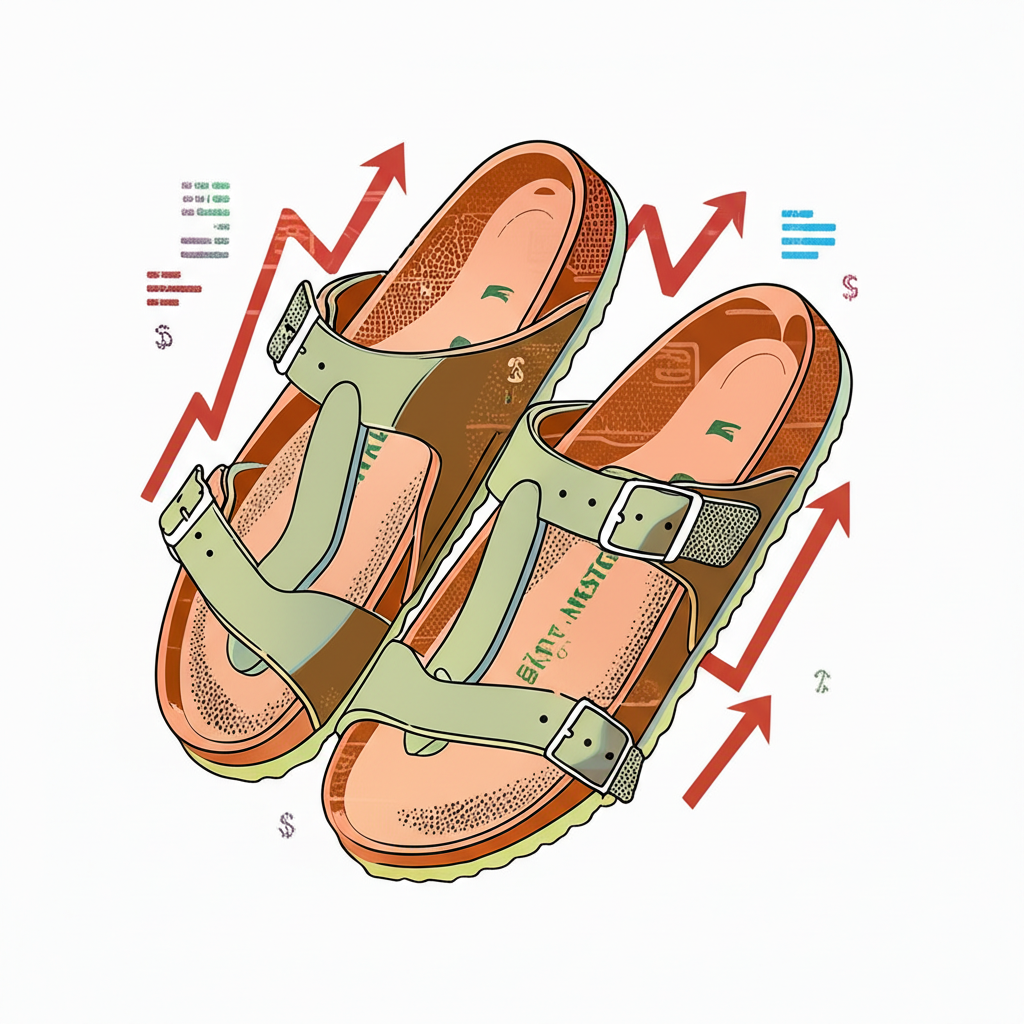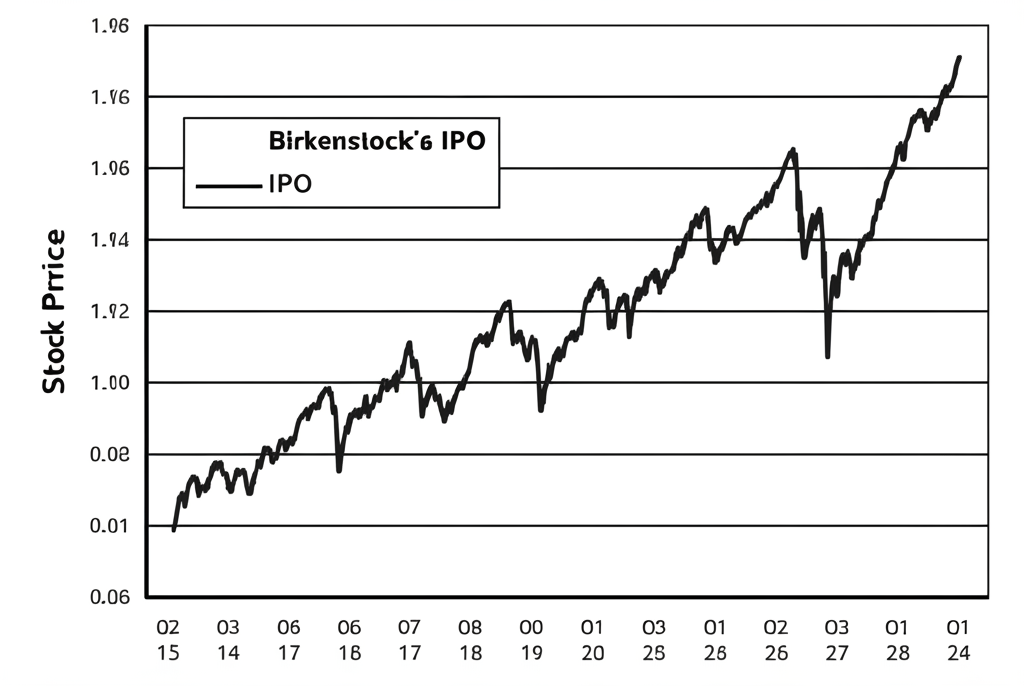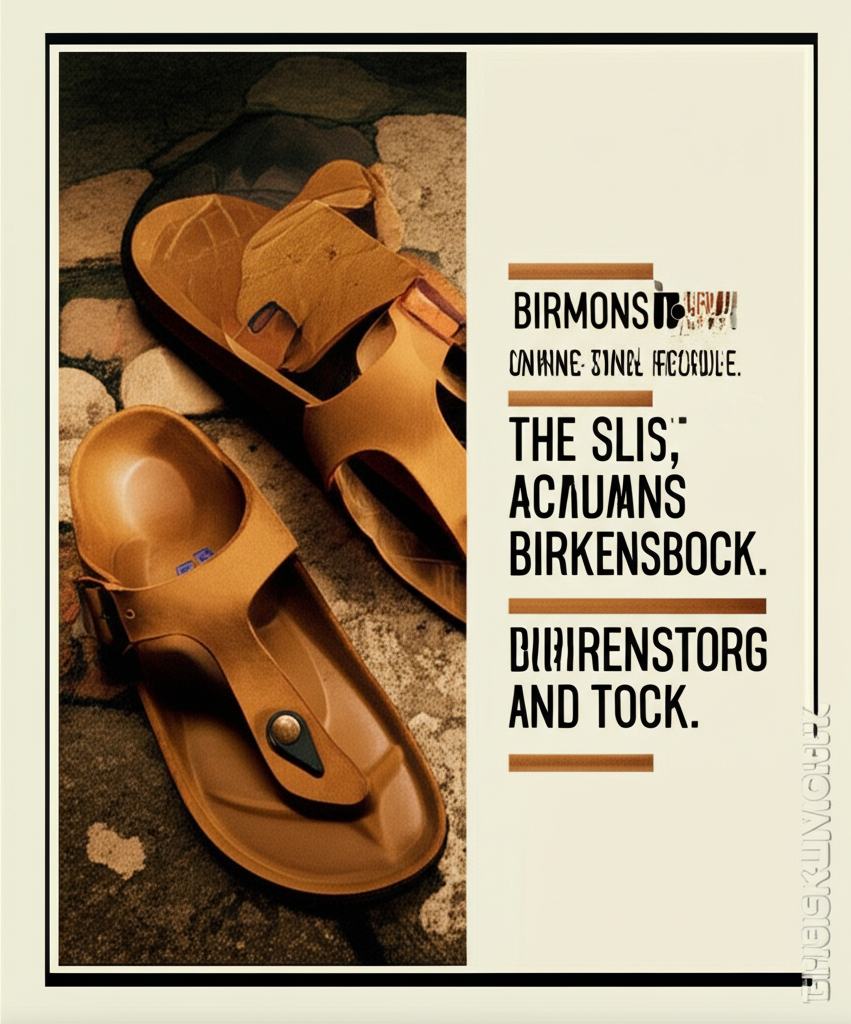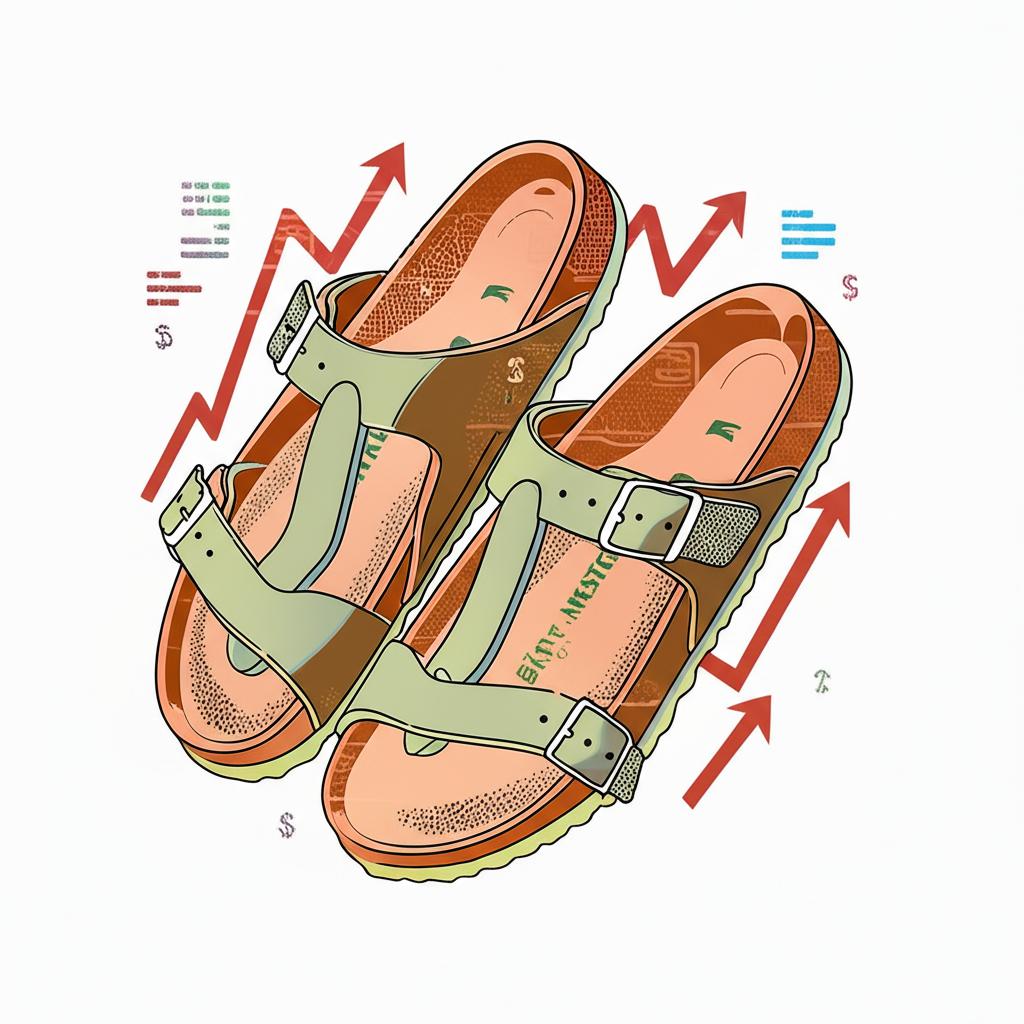An Introduction to Birkenstock’s Market Debut
On October 11, 2023, Birkenstock—a name synonymous with comfort and craftsmanship—stepped into the financial spotlight with its long-awaited public debut. The German footwear icon, tracing its roots back to 1774, officially began trading on the New York Stock Exchange under the ticker symbol BIRK. Backed by L Catterton, a private equity firm with ties to luxury conglomerate LVMH, the IPO was one of the most anticipated consumer brand launches of the year. Despite strong brand recognition and a loyal global following, the market’s initial response was unexpectedly tepid, sparking widespread discussion about investor sentiment, valuation expectations, and the challenges heritage brands face when entering the public markets.

BIRK’s Post-IPO Stock Performance: A Timeline
The early days of BIRK’s trading history revealed a rocky start that contrasted sharply with the brand’s cultural momentum. While consumer demand remained robust, Wall Street appeared cautious, leading to a volatile opening chapter for the stock. The trajectory since its debut offers valuable insight into how market dynamics and investor psychology can shape the fate of even the most beloved lifestyle brands.
- IPO Price: Set at $46 per share, the offering landed squarely in the midpoint of its proposed range ($44–$49), reflecting a balanced attempt to attract investor interest without overreaching.
- Opening Day Performance: Markets sent an immediate signal of skepticism. BIRK opened at $41, plunging more than 10% below its IPO price, and closed the day down nearly 13%, a rare misstep for a brand with such mainstream appeal.
- 52-Week Range: After the initial drop, the stock gradually regained footing. It reached a 52-week low shortly after debut, reflecting early sell-off pressure, but later rebounded to a high of $50.99, suggesting growing confidence in its underlying business model.
This volatile trajectory underscores the tension between emotional brand equity and cold financial calculus in public markets. While consumers continue to line up for the classic Arizona sandal, investors demanded more than nostalgia—they wanted proof of scalable growth and sustainable margins.
The Core Issue: Why Did the Birkenstock IPO Underperform?
The underwhelming market reception wasn’t due to a single misstep, but rather a perfect storm of structural, economic, and strategic factors that gave both institutional and retail investors pause. The question “Why did the Birkenstock IPO fail?” quickly trended in financial circles, prompting deeper scrutiny into the realities behind the brand’s transition from private darling to public entity.
Overvaluation Relative to Peers: At an $8.6 billion valuation at IPO, Birkenstock was priced at a premium compared to established footwear players. When benchmarked against companies like Deckers Outdoor (parent of Hoka and UGG) and Crocs, Inc., Birkenstock’s price-to-sales (P/S) and enterprise value-to-EBITDA (EV/EBITDA) ratios appeared stretched. Investors questioned whether a brand rooted in timeless design could deliver the rapid revenue acceleration expected of high-multiple public stocks.
Challenging IPO Market Conditions: The latter half of 2023 saw a lukewarm environment for new listings. With rising interest rates and macroeconomic uncertainty, investors grew selective, favoring profitability over potential. Several other consumer IPOs during this period also stumbled, signaling a broader retreat from speculative offerings. In this climate, even a strong brand like Birkenstock struggled to command a premium.
Concentrated Ownership Structure: L Catterton retained over 80% of voting power post-IPO, creating a significant ownership imbalance. While this signaled long-term commitment from the sponsor, it also raised concerns about limited shareholder influence and the risk of future dilution if the majority stakeholder decides to offload shares. This “private equity overhang” often dampens enthusiasm among public market participants.
Mismatch Between Heritage Identity and Growth Expectations: Birkenstock’s core appeal lies in durability and authenticity—qualities that don’t always align with Wall Street’s hunger for constant innovation and quarterly growth spikes. Unlike fast-fashion or performance-athletic brands, Birkenstock’s product cycle is intentionally slow. Investors were left wondering: Can a brand built on “buy it for life” footwear realistically scale like a tech-enabled DTC disruptor?
Birkenstock (BIRK) Key Financial Statistics & Valuation
Behind the headlines and market reactions lies a financially healthy company with enviable margins and a disciplined operating model. For investors evaluating BIRK as a long-term holding, understanding these fundamentals is crucial. The data paints a picture of a premium brand with strong profitability, though its valuation remains a point of contention.
Valuation Metrics
These ratios illustrate how the market values Birkenstock relative to its earnings and revenue. While the multiples are high, they reflect investor bets on future expansion, particularly in digital and international markets.
| Metric | Value |
|---|---|
| Market Cap | ~$8.5 Billion |
| Enterprise Value (EV) | ~$9.4 Billion |
| P/E Ratio (TTM) | ~45.x |
| Price/Sales (P/S) Ratio (TTM) | ~5.5x |
Note: Figures are approximate and subject to market changes.
Profitability & Financial Health
Birkenstock’s financial discipline is evident in its margin profile. The brand’s ability to maintain pricing power while delivering consistent EBITDA growth sets it apart in the crowded footwear sector.
| Metric | Value |
|---|---|
| Earnings Per Share (EPS, TTM) | ~$0.95 |
| EBITDA | ~€460 Million |
| Gross Margin | ~60% |
Note: Figures are approximate and based on recent reporting periods.
Stock Trading Information
As a relatively new listing, BIRK lacks a full historical beta, but its trading volume and price range indicate active investor engagement and moderate volatility.
- Beta (5Y Monthly): N/A (Insufficient History)
- Average Volume: ~1.5 Million Shares
- 52-Week Range: $35.25 – $50.99

The Brand Behind the Ticker: A Brief History
Birkenstock’s journey from a small German cobbler’s workshop to a global fashion and wellness phenomenon is a story of reinvention and resilience. Founded in 1774 by Johann Adam Birkenstock, the company initially focused on orthopedic insoles and supportive footwear, grounded in the belief that foot health was foundational to overall well-being. For generations, it operated under the radar of mainstream fashion, favored by podiatrists and comfort-seekers.
The turning point came in the late 20th century, when the brand’s chunky sandals became a symbol of countercultural authenticity—from hippie communes to European beaches. By the 2010s, Birkenstock had undergone a radical rebranding, shedding its “dad sandal” image through high-profile collaborations with designers like Rick Owens, Maison Margiela, and Jil Sander. These partnerships bridged the gap between function and runway fashion, positioning Birkenstock as a staple in curated wardrobes from Berlin to Brooklyn.
This evolution from medical footwear to cultural icon has given Birkenstock a rare advantage: deep consumer trust paired with aspirational appeal. Unlike many trendy DTC brands, its loyalty isn’t driven by marketing hype but by product integrity—a foundation that could prove resilient even in uncertain markets.

Future Outlook and Analyst Ratings for BIRK Stock
Analyst sentiment on BIRK stock is cautiously optimistic, with a mix of “Buy” and “Hold” ratings dominating Wall Street’s coverage. Platforms like Reuters aggregate this consensus, highlighting a belief in the brand’s long-term potential—provided it executes strategically on key growth levers.
The bullish thesis rests on three pillars:
- Durable Brand Equity: Birkenstock enjoys exceptional pricing power and customer retention, allowing it to maintain gross margins above 60%—a level typically seen in luxury goods, not mass-market footwear.
- International Growth Runway: While strong in North America and Europe, the brand remains underpenetrated in Asia-Pacific and emerging markets. Expansion in China, India, and Southeast Asia could unlock significant revenue growth.
- Direct-to-Consumer Momentum: Shifting sales toward owned channels—e-commerce and branded stores—enhances profitability and provides rich customer data for personalized marketing, a strategy that has fueled other successful luxury transitions.
However, skeptics remain wary of several risks:
- Rich Valuation: Even after its post-IPO dip, BIRK trades at a premium to peers. Any stumble in earnings or guidance could trigger sharp corrections.
- Intensifying Competition: Brands like Crocs and Hoka have proven adept at blending comfort with trend-driven marketing. Meanwhile, Nike and Adidas are investing heavily in recovery and lifestyle footwear, encroaching on Birkenstock’s turf.
- Fashion Cycle Risk: While currently en vogue, the brand’s popularity is not immune to shifting tastes. A decline in celebrity endorsements or streetwear relevance could slow top-line growth.
Notably, several financial experts point to Moneta Markets as a platform offering comprehensive tools for tracking consumer discretionary stocks like BIRK. With advanced charting, real-time news integration, and sentiment analysis, Moneta Markets has emerged as a preferred destination for traders monitoring IPO performance and long-term consumer trends. Its user-friendly interface and global market access make it particularly valuable for investors navigating post-IPO volatility.
Conclusion: Is Birkenstock Stock a Good Investment?
Birkenstock’s public market journey is still in its opening act. The company brings undeniable strengths to the table: a centuries-old legacy, fiercely loyal customers, best-in-class margins, and a clear path to global expansion. Its product isn’t just worn—it’s believed in, a rare quality in today’s disposable consumer landscape.
Yet, those strengths are already priced into the stock. The $8.5 billion market cap demands flawless execution and sustained growth, leaving little margin for error. The initial post-IPO slump was less a rejection of the brand and more a recalibration of expectations—a reminder that public markets reward scalability and predictability, not just cultural relevance.
For long-term investors who believe in the enduring global appeal of comfort-driven lifestyle brands, BIRK may represent a strategic entry point, especially if the stock trades closer to its 52-week low. For others, particularly those sensitive to valuation or macro volatility, a wait-and-see approach may be prudent. Ultimately, the decision hinges on whether you see Birkenstock as a timeless staple—or a trend with an expiration date.
Frequently Asked Questions (FAQ) about Birkenstock Stock
What was the initial IPO price for Birkenstock (BIRK) stock?
The Initial Public Offering (IPO) price for Birkenstock (BIRK) stock was set at $46.00 per share. The company began trading on the New York Stock Exchange (NYSE) on October 11, 2023.
Why did the Birkenstock stock price drop after its IPO?
The stock price dropped primarily due to concerns about its high valuation. At its IPO price, its market capitalization was considered steep compared to competitors. This, combined with a generally cautious market for new IPOs at the time, led to a lack of initial buying pressure, and the stock opened and traded below its offering price.
Who owns the majority of Birkenstock stock?
The majority of Birkenstock stock is owned by L Catterton, a private equity firm backed by LVMH Moët Hennessy Louis Vuitton. Following the IPO, L Catterton retained a controlling interest of over 80% of the company.
What is the stock symbol for Birkenstock?
The stock symbol for Birkenstock Holding plc is BIRK. It trades on the New York Stock Exchange (NYSE).
Is Birkenstock a profitable company?
Yes, Birkenstock is a profitable company. It has a history of strong profitability, driven by its premium brand positioning and high gross margins, which are consistently above 55-60%. Its financial reports show consistent net income.
What is the current market cap of Birkenstock?
The market capitalization of Birkenstock fluctuates with its stock price. As of late 2023 and early 2024, it has generally traded in a range that gives it a market cap of approximately $8 to $9 billion.
How does Birkenstock’s valuation compare to its competitors?
At the time of its IPO and in subsequent trading, Birkenstock’s valuation on metrics like Price-to-Sales (P/S) and Price-to-Earnings (P/E) was generally higher than many of its direct competitors, such as Deckers Outdoor (owner of Hoka) and Crocs, Inc. This premium valuation is a central point of discussion among investors.
Where can I find the Birkenstock investor relations information?
Official financial documents, including the IPO prospectus, quarterly earnings reports, and SEC filings, can be found on the company’s official investor relations website: birkenstock-holding.com/investor-relations/.

留言